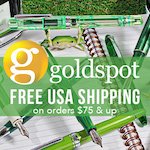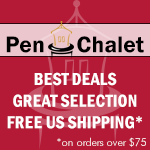(Susan M. Pigott is a fountain pen collector, pen and paperholic, photographer, and professor. You can find more from Susan on her blog Scribalishess.)
All fountain pen aficionados know that the soul of a pen is its nib. No matter how beautiful the body of the pen is, if it doesn't write well, it loses its purpose in life. I've chosen some of my favorite nibs and why they are, in my view, fantastic. With one exception, all the nibs below are factory nibs that worked perfectly straight out of the box. Although I own spectacular nibs ground by nibmeisters, I wanted to focus on nibs that anyone can buy without special grinding.
Pilot Metropolitan Fine
Many people say that the Pilot Metropolitan is the gateway pen to fountain pen addiction. I have to agree. The nib is steel but smooth and uncomplicated. I've bought three Pilot Metropolitan Retro Pops, and all three write consistently well.
Pilot Retro Pop Fine Nib
The turquoise Retro Pop is my all-time favorite grading nib coupled with Diamine Marine (less scary than red). Smooth, perfect flow and $15.00–what is not to love? You can find these pens with their stellar nibs at many vendors, including JetPens.
Lamy 2000 Makrolon Fine
I got my Lamy 2000 through Massdrop, and, unfortunately, the original nib was awful. One of the tines was longer than the other and the pen was unusable.
Lamy 2000 Fine Nib
Franklin-Christoph Marietta with a Gold Masuyama Medium Italic
I love Franklin-Christoph fountain pens. I would buy one of each if I could. The best part is you can get a pre-ground nib by nibmeister par excellence Mike Masuyama, without having to stand in a long line at a pen show or get in his business queue (which is months long).
Franklin-Christoph 18K Gold Medium Cursive Italic Nib
This is one of my favorite writing pens. I opted for the gold Medium italic and it is just terrific–no scratchiness, just beautiful, precise lines. You can get Masuyama nibs on virtually any Franklin-Christoph model.
Pilot Custom Heritage 912 with FA Nib
I reviewed this pen a few months back on Pen Addict. As I said in that review, there's nothing really remarkable about the pen itself since it's a typical black pen.
Pilot FA Nib
Pilot Custom Heritage 823 Medium
The Pilot Custom 823 is one of those pens that almost everyone adores. Its vacuum filling system, size, and simple beauty are all a testament to the pen's popularity. But the thing that sets it apart from all the other cigar-shaped fountain pens is its huge, gorgeous nib. I love this nib.
Pilot 823 Medium Nib
Here's the key, though. If you want a smooth writing experience with the 823 nib, I recommend you go with a medium (or larger) nib. With extra fine or fine nibs you may wind up with something scratchy that digs into the paper. It's not that Pilot extra-fine or fine nibs are bad, but they are much finer than Western pens and the medium nib on my 823 writes like a true fine–one of the smoothest fine nibs I own. Goldspot and Goulet carry these pens as do many other vendors.
Graf von Faber Castell Intuition Terra Cotta Oblique Medium
In order to get a factory oblique medium nib, I had to purchase this nib from Martini Auctions (no American vendors stock these nibs). The price for the pen was definitely competitive (less than some American vendors without the OM nib), so I didn't mind the fact that it took a little longer to obtain from overseas.
Graf von Faber Castell Oblique Medium Nib
It has a nice crisp line but none of the strict positioning that can come with a cursive italic nib. I like obliques since I tend to hold my pens at an angle. The Graf von Faber Castell Intuition in Terra is difficult to find these days, but you can get other models. I'd suggest Martini Auctions if you're interested in nibs other than the standard medium.
Sailor Cross Concord
I reviewed this nib a couple of months ago along with the Sailor Cross Point. The Concord is definitely my favorite of the two because its standard position writes like a normal fine nib. But if you want some swishy, fat goodness, you just flip the pen over and glide away.
Sailor Cross Concord Nib
Sailor Specialty nibs are expensive and right now are difficult to obtain. You can order them from nibs.com and now from Anderson Pens.
Omas Ogiva Factory Italic
Omas Ogiva Factory Italic Nib
Regardless, it writes as smoothly as Ella Fitzgerald singing "Summertime." Sadly, since Omas is now out of business, it's much more difficult to purchase any of their pens, especially those with special nibs. Keep an eye out for sales on FPN and other Internet sites.
Montblanc Heritage 1912 Fine
This nib isn't huge and it isn't ornate, but it writes beautifully. Of course, you wind up paying a premium for the pen, not because of the nib, but because of the safety pen mechanism and the Montblanc name.
Montblanc Heritage 1912 Fine Nib
I love the retro-feel of this pen (see my review here). It's substantial and heavy (the barrel is made of metal), but the nib has a vintage spring to it that makes it a joy to write with. I bought my Montblanc Heritage 1912 from a seller on FPN. It's available through Montblanc and occasionally other online vendors.
Pelikan M400 White Tortoise with Factory OBB Nib
Although I prefer the M600 size Pelikans, I bought this beauty from Rick Propas. It was part of a collection he was selling and came with a factory OBB nib at an unbelievable price. It is a spectacular writer, inked with Pelikan Edelstein Amber (the only pen lucky enough to warrant that ink).
Pelikan M400 OBB Nib
It's getting more and more difficult to find Pelikans with italic or oblique nibs, especially the BB and BBB size, so you either have to buy vintage or seek out vendors that have these nibs in stock. Expect to pay a hefty amount for one of these Pelikan nibs. Classic Fountain Pens is one source for special-sized Pelikan nibs. You can also contact Rick Propas to see what he has in stock.
Nibs can be hit or miss depending on the fountain pen brand. I've had bad luck with Visconti and Kaweco nibs. I've read several discussions about the lack of size consistency of Pelikan nibs. Lamy nibs tend to get rave reviews or the exact opposite, which I'm sure is a quality control problem. I've even read reviews of bad Nakaya nibs–something I never thought possible.
The reality is that nibs don't always write well straight out of the box. Every user's experience may vary. It's always possible that you will get a poorly aligned nib, or a feed that doesn't offer enough flow for a particular nib, or tines that are different sizes, or a nib that is just plain scratchy. That's why it's always good to read return and exchange policies for fountain pens. When you buy from individual sellers rather than vendors, you may not get a refund if the nib is not to your liking. So, as one of my pen friends wisely suggested, if you buy a used pen, factor in the cost of a nibmeister along with the cost of the pen.
























































